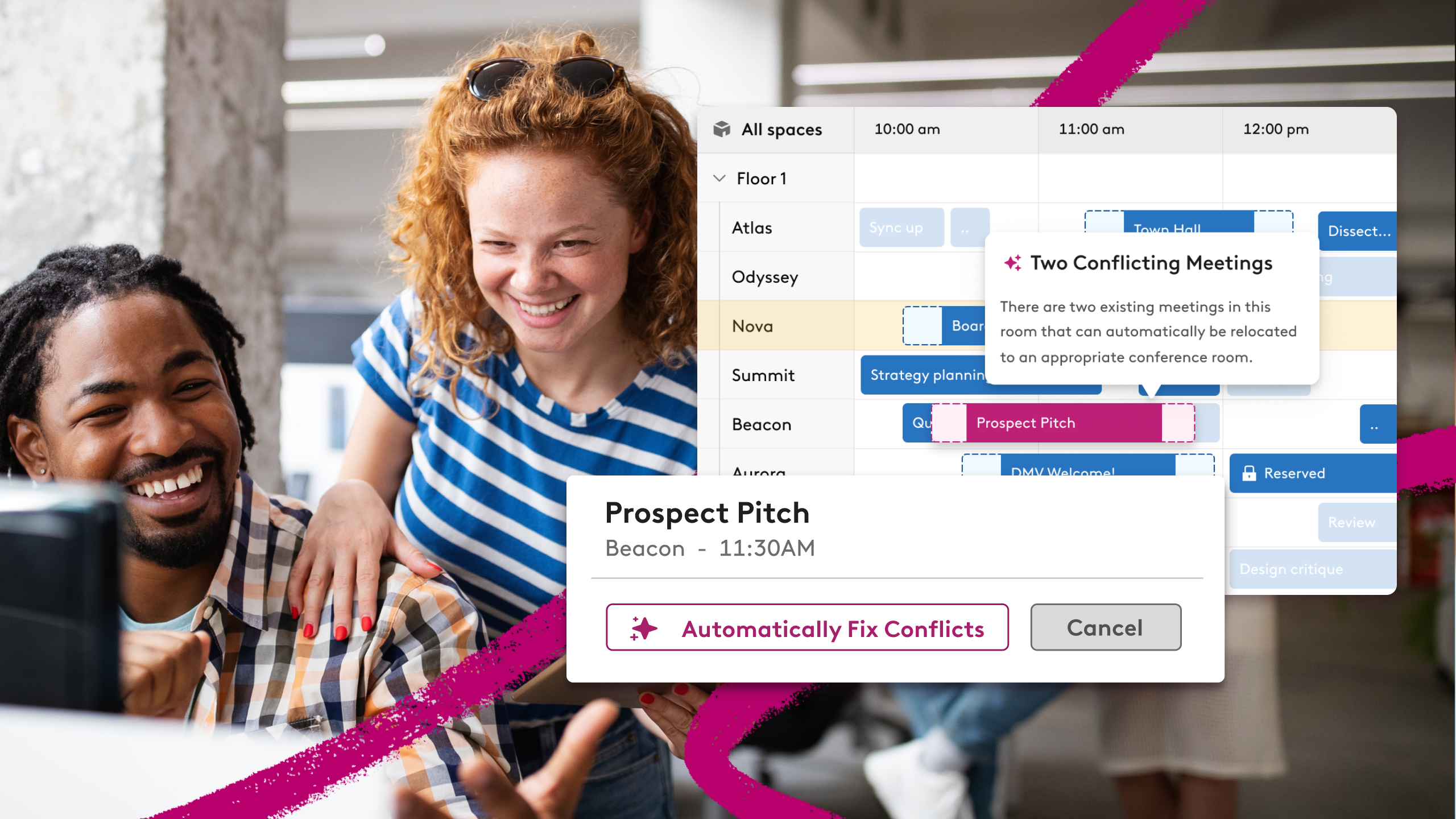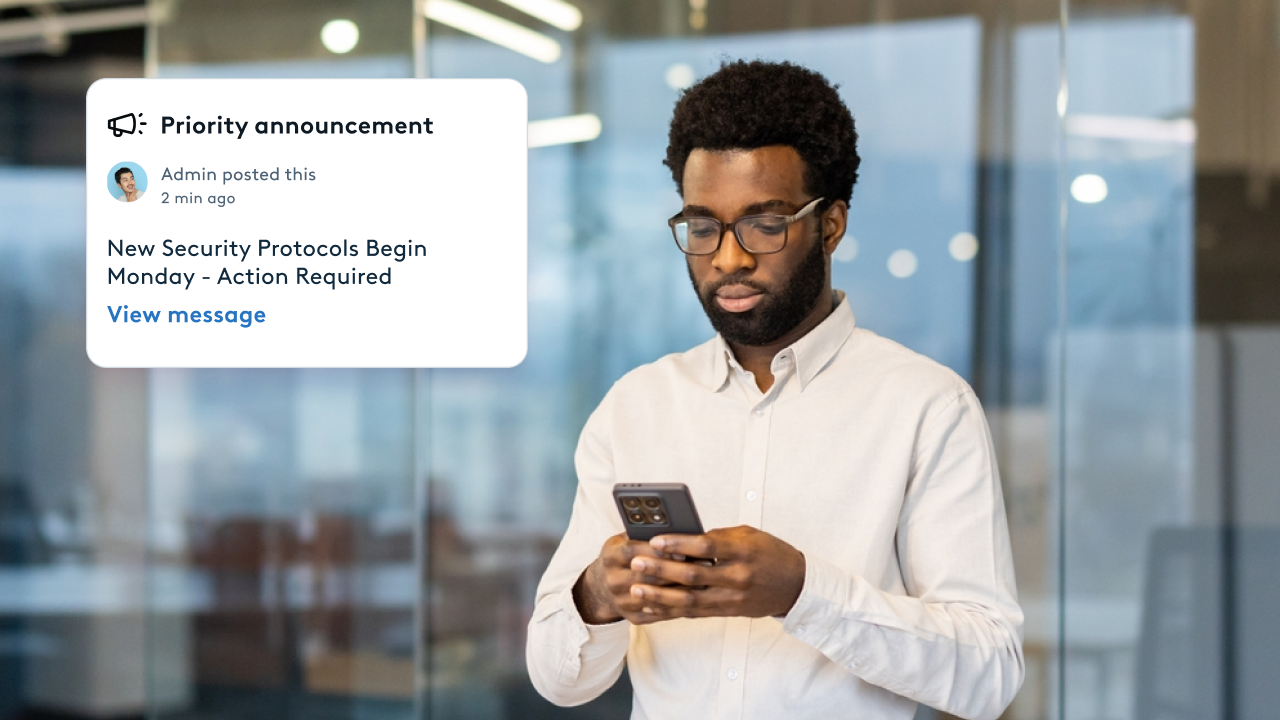No Wandering, No Wondering: Wayfinding Solutions for the Modern Office

No one likes the feeling of being lost, especially when they’re trying to be productive or meet a potential new employer or business partner. Whether you’re new to the office or visiting a different department on a large campus, good wayfinding is the key to easy indoor navigation. There are many ways to achieve this, both high and low-tech.
As technology becomes further integrated into the workday, the focus on improving digital wayfinding through the use of digital signage, digital floor plans, and interactive maps has become even more prevalent.
Today, we’ll look at the components of good wayfinding solutions, learn more about its potential to improve both employer goals and employee experience, and explore the ways technology can make this process even easier.
Want to improve wayfinding in your office? We can help. See how today.
What are wayfinding solutions?
Wayfinding, by definition, refers to any displays or informational signage that helps people make their way through a commercial or public space. It can take the form of placards, signage, traffic flow stickers, or analog/digital signboards that point people in the right direction or give them more details on a space. This can be as simple as an arrowed restroom sign, or as elaborate as an interactive, touchscreen-enabled status board or conference room booking system. A good wayfinding system has many interconnected components.

Wayfinding solutions improve life in the office in many ways:
- Make occasional visitors, vendors, and guests more comfortable and more confident to navigate the space independently.
- Improves the new employee experience by giving them directional signs for getting around their new office.
- Makes daily tasks like finding a colleague, an open meeting room, or your own desk way easier
- Improves accessibility and visibility for office resources. No one should have to bug the front desk where the printer is.
At the end of the day, the best digital wayfinding solutions blend into the environment so seamlessly as to go unnoticed. In the best scenario, most people passing through the office or public space won’t even realize they’re benefitting from the outcome of a thoughtfully implemented design approach. The natural direction of your signage and information (both subtle and explicit) is what separates “good enough” wayfinding from truly unique and enjoyable design.
Destination meets design
Wayfinding design should be part of your overall space planning in order to achieve the best results and comfort within the built environment. That being said, wayfinding doesn’t have to be boring. There are endless possibilities and office design ideas to play with that will make your wayfinding both informative and visually appealing.
How do office wayfinding solutions benefit employers?
Good wayfinding design, wayfinding signage, and implementation is, first and foremost, a visual indicator of the overall functioning of the organization. It can be a powerful recruiting and retention tool when thoughtfully implemented. It provides a subtle statement about the values and mission of the company.
- Candidates that see a well-organized office environment and appealing wayfinding signage are more likely to form a good impression of the company, making it easier to get top talent in the door.
- Offices that feel comfortable and easy to navigate for staff can improve retention and keep turnover down. This is especially true for design that sets a strong focus on branding, as it gives the office community a feeling of cohesion and common purpose.
- On a daily basis, removing friction from employees's days who frequent the often most adds to an overall improved workplace experience.
- Offices that present a well-designed and tasteful way finding approach can impress a visitor, offering a subtle air of professionalism and sound practice to potential partners or investors.

In the current pandemic, good digital wayfinding and signage can be especially helpful in getting everyone in the workspace where they need to go safely, with all the information necessary to practice good social distancing and minimize travel between departments. It can also provide traffic flow cues through directional signage on floors or freestanding in halls.
For large offices that house significant in-house populations (even while practicing reduced density) a digital wayfinding kiosk is a good interactive solution for getting people around the office safely. It can let people know who is in, where they’re sitting, and provide an easy system for organizing meetings when facetime is a must.
How do office wayfinding solutions benefit employees?
Wayfinding isn’t just about getting people from A to B. The thoughtful design of your office and its informational signage can create positive feelings for your people and bring teams together in powerful ways.
For instance, offices that offer strong branding within their design and wayfinding choices can inspire positive feelings in those who engage in the environment daily. There are many positive associations with having an appealing and functional design, that makes staff feel more at home in their daily surroundings. This is especially true for offices that include a strong cultural component in their design. For instance, using naming conventions that evoke the company’s geographic location or values provides a small point of pride and connection on the workday. Likewise, design that integrates the employees individual cultural or social touches can forge even stronger connections to the place they go to to get things done.
Digital wayfinding can also improve workplace efficiency, by providing clear, consistent direction that operates without a lot of thought or concentration. This intentional design and ease of use means employees spend less time finding work spaces, locating colleagues, navigating to new buildings or departments using a facility map, and so on. This frictionless, digital workplace leaves more bandwidth and more time for getting to grips with the important work of the day.
An interactive wayfinding solution and a smart office approach to wayfinding design can also make collaboration and meeting easier. When it’s easy to locate a room, book it interactively, invite your key players, and make best use of both time and space, it improves employee productivity and presents staff with fewer obstacles during their working hours.
What should you look for in an office digital wayfinding solution?
Wayfinding solutions can be high tech without being complicated. When looking to model your wayfinding to meet the demands of the modern workplace, there are a few components you’ll find desirable as you research the digital wayfinding solutions market:
A top-notch wayfinding sign strategy and interactive wayfinding software will allow users to either book their needs (hot desks, meeting rooms, and other spaces) from a kiosk, a room display touch screen, or from the convenience of a wayfinding app or web dashboard. Some also offer the option of searching and booking space via corporate communications tools like Slack and Microsoft Teams. Because the booking is fully digital, employees can book and check into their future work space with minimal friction. It's all about meeting employees in the tools and spaces they already frequent.

An interactive status board (a real-time peek into office happenings either displayed as a map or a list of events for the day) offers next-level digital wayfinding, allowing users to locate the person, meeting space, or department they want to visit, and creating easy guidance through the office.
Good digital wayfinding in the age of COVID-19 also includes telling visitors and staff where they shouldn’t go. Therefore, a quality interactive booking system will show rooms or hot desks that are unavailable due to maintenance, cleaning, or capacity restrictions.
—
Though you could tack up an office map by the water cooler and call it a day, that won't be quite enough to help employees navigate and interact with the office meaningfully. Wayfinding solutions and thoughtful design are worthwhile investments for workplace teams looking to improve their employees' experience.













